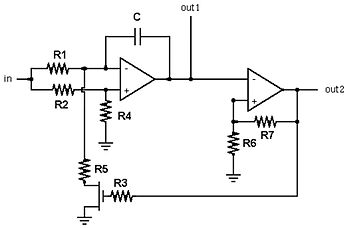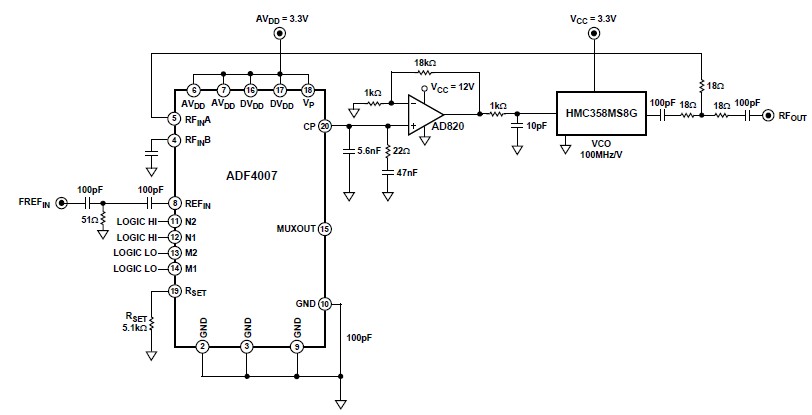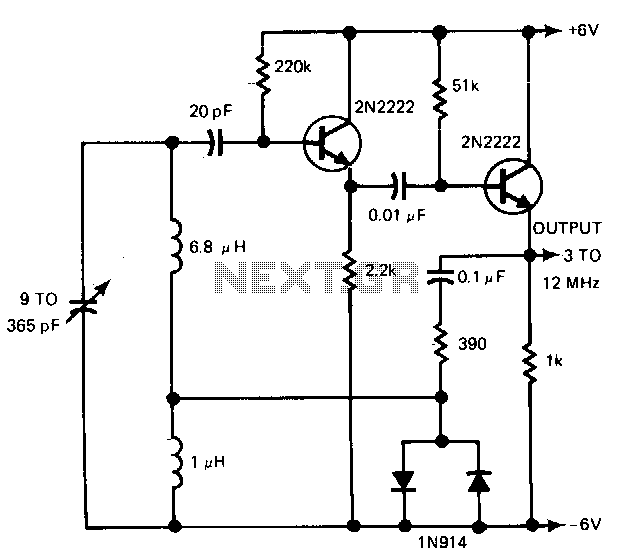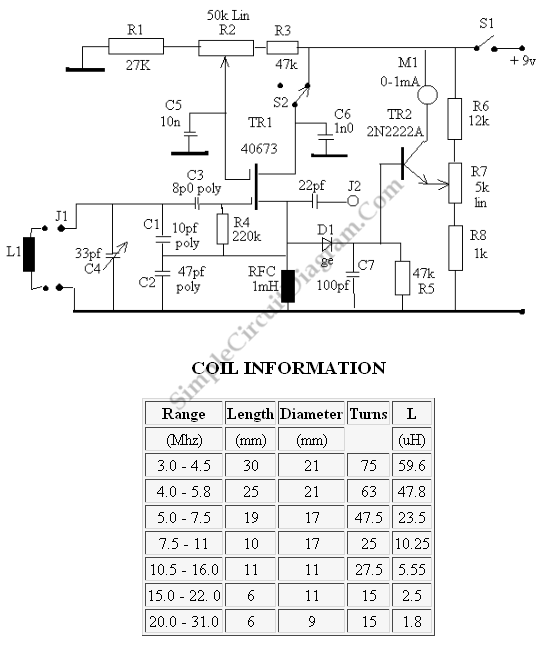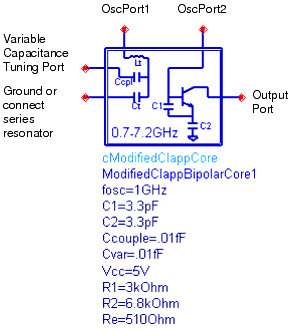
Wien bridge oscillator
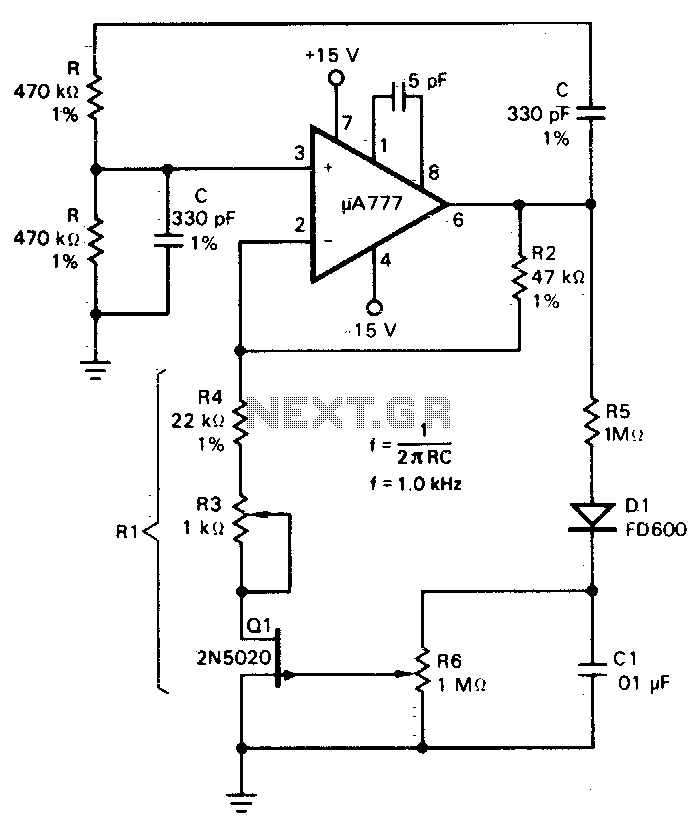
A field effect transistor (FET), designated as Q1, functions within the linear resistive region to facilitate automatic gain control. The attenuation of the RC network is one-third at the oscillation frequency with zero phase shift, necessitating that the amplifier gain, determined by resistor R2 and the equivalent resistor R1, be precisely three to satisfy the unity gain positive feedback requirement essential for stable oscillation. Resistors R3 and R4 are configured to be approximately 1000 ohms lower than the required resistance of R1. The FET dynamically adjusts to provide the necessary trimming resistance, ensuring that R1 is half the resistance of R2. Additionally, the circuit comprising R5, D1, and C1 serves to isolate, rectify, and filter the output sine wave, transforming it into a DC potential that controls the gate of the FET. Under the low drain-to-source voltage conditions employed, the FET exhibits symmetrical linear resistance corresponding to a given gate-to-source voltage.
The circuit design incorporates a field effect transistor (FET) as a critical component in achieving automatic gain control. The operation of the FET in the linear resistive region is vital for maintaining stable oscillation conditions. The RC network's attenuation characteristic is specifically tuned to one-third at the zero phase-shift oscillation frequency. This tuning is crucial as it dictates that the gain of the amplifier, defined by the relationship between resistors R2 and R1, must equal three. This ratio ensures that the positive feedback loop achieves unity gain, which is a prerequisite for stable oscillatory behavior.
Resistors R3 and R4 are strategically selected to be approximately 1000 ohms less than the target resistance of R1. This selection allows for fine-tuning of the gain control mechanism, providing a buffer within the circuit's operational parameters. The FET plays a significant role in dynamically adjusting the resistance value of R1, allowing it to be half the value of R2. This dynamic adjustment is essential for maintaining the desired gain characteristics of the circuit.
Moreover, the circuit segment consisting of R5, D1, and C1 is designed for signal processing. It effectively isolates the output sine wave generated by the oscillation, rectifying and filtering it to produce a stable DC voltage. This DC potential is then utilized to control the gate of the FET, ensuring that the device operates within its optimal parameters. The low drain-to-source voltages employed in this configuration enable the FET to provide a symmetrical linear resistance, which is advantageous for achieving consistent performance in response to varying gate-to-source voltage levels. This design approach highlights the sophistication and precision required in analog circuit design, particularly in applications involving automatic gain control and oscillatory systems.Field effect transistor, Ql, operates in the linear resistive region to provide automatic gain control. Because the attenuation of the RC network is one-third at the zero phase-shift oscillation frequency, the amplifier gain determined by resistor R2 and equivalent resistor R1 must be just equal to three to make up the unity gain positive feedback requirement needed for stable oscillation.
Resistors R3 and R4 are set to approximately 1000 ohm less than the required R1 resistance. The FET dynamically provides the trimming resistance needed to make R1 one-half of the resistance of R2 The circuit composed of R5, Dl, and CI isolates, rectifies, and filters the output sine wave, converting it into, a dc potential to control the gate of the FET. For the low drain-to-source voltages used, the FET provides a symmetrical linear resistance for a given gate-to-source voltage.
🔗 External reference
The circuit design incorporates a field effect transistor (FET) as a critical component in achieving automatic gain control. The operation of the FET in the linear resistive region is vital for maintaining stable oscillation conditions. The RC network's attenuation characteristic is specifically tuned to one-third at the zero phase-shift oscillation frequency. This tuning is crucial as it dictates that the gain of the amplifier, defined by the relationship between resistors R2 and R1, must equal three. This ratio ensures that the positive feedback loop achieves unity gain, which is a prerequisite for stable oscillatory behavior.
Resistors R3 and R4 are strategically selected to be approximately 1000 ohms less than the target resistance of R1. This selection allows for fine-tuning of the gain control mechanism, providing a buffer within the circuit's operational parameters. The FET plays a significant role in dynamically adjusting the resistance value of R1, allowing it to be half the value of R2. This dynamic adjustment is essential for maintaining the desired gain characteristics of the circuit.
Moreover, the circuit segment consisting of R5, D1, and C1 is designed for signal processing. It effectively isolates the output sine wave generated by the oscillation, rectifying and filtering it to produce a stable DC voltage. This DC potential is then utilized to control the gate of the FET, ensuring that the device operates within its optimal parameters. The low drain-to-source voltages employed in this configuration enable the FET to provide a symmetrical linear resistance, which is advantageous for achieving consistent performance in response to varying gate-to-source voltage levels. This design approach highlights the sophistication and precision required in analog circuit design, particularly in applications involving automatic gain control and oscillatory systems.Field effect transistor, Ql, operates in the linear resistive region to provide automatic gain control. Because the attenuation of the RC network is one-third at the zero phase-shift oscillation frequency, the amplifier gain determined by resistor R2 and equivalent resistor R1 must be just equal to three to make up the unity gain positive feedback requirement needed for stable oscillation.
Resistors R3 and R4 are set to approximately 1000 ohm less than the required R1 resistance. The FET dynamically provides the trimming resistance needed to make R1 one-half of the resistance of R2 The circuit composed of R5, Dl, and CI isolates, rectifies, and filters the output sine wave, converting it into, a dc potential to control the gate of the FET. For the low drain-to-source voltages used, the FET provides a symmetrical linear resistance for a given gate-to-source voltage.
🔗 External reference

